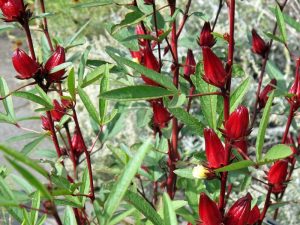Rosella/roselle
Robin Gale-Baker, from Sustainable Macleod, discusses rosella/roselle. This is one of a series of articles she has written about growing various herbs (see right hand sidebar). She has also written a number of articles about growing various veggies, growing various fruit trees and general growing techniques. If you want to read more about the various herbs, she recommends The Encyclopedia of Herbs and Herbalism, edited by Malcolm Stuart and originally published in 1979.
 Rosella (Hibiscus sabdariffa), known as Roselle in countries other than Australia, is not an Australian native (as many people seem to think) but from West Africa.
Rosella (Hibiscus sabdariffa), known as Roselle in countries other than Australia, is not an Australian native (as many people seem to think) but from West Africa.
It is a bush that produces ruby red calyxes that make tasty jams or cordials, leaves that are used in tea making and salads, and an outer stem covering that can be stripped and used like jute. There are many good recipes for jams and cordials on the internet.
Seed raising
In Melbourne’s climate, it is best to raise the seeds in pots so that the plants are well established by the time the soil temperature has reached at least 20degC. Plant three seeds per pot 1cm deep in seed raising mix, keep well watered and, later, thin out leaving the strongest. Sow seeds in mid-August. The seedlings will grow into bushes that can be as wide as 1.5 metres and as high as 2 metres.
Position, bed and water
In our climate, plant the seedlings in the hottest part of the garden in full sun, preferably in a raised bed or wicking bed to keep the lower branches off the soil and out of reach of pests. Wicking beds are ideal as rosella is a plant requiring heavy watering (at least every 2-3 days if not in a wicking bed).
Soil and planting
Rosella needs rich soil with plenty of compost and must be well drained. They are heavy feeders. When the buds are forming, apply more compost. If planting in a garden bed, plants can be as far as 1 metre apart. In a raised bed, plant them 50cm apart and the branches will intersperse a bit like a hedge. You will need to plant 6-7 plants to get a decent harvest.
Plant out in mid-late October. Rosella needs a long summer – at least 6 months of hot sun – so there is little leeway for plants to mature if planted later than October. The calyxes develop as the days shorten. There are two flushes of calyxes – the first is sometimes light but the second will be heavy and occurs when the plant puts all its energy into reproducing before dying off. Technically, it is a perennial but treat it as an annual as cold weather and frost kill it.
Harvesting and preparing
When the calyxes are 25-30cm in diameter, they are ready to harvest. Use secateurs or sharp scissors to cut them as the stems are quite thin and fragile. Store them in the fridge until you have enough to use. Inside the calyx is a big seed pod that needs to be removed. Peel the petals of the calyx from the seed pod but keep the seed.
Seed saving
Either save the seed when you prepare the calyxes for processing or leave some calyxes on the plants to dry (just as you would with peas or broad beans). The seed comes out easily: just tap the calyx on to your hand and it will fall out. Not all seed is equally viable so it is worth planting extra to ensure sufficient plants. Seeds are sold by Diggers, The Seed Collection, Eden Seeds and Seed Freaks in Tasmania.
